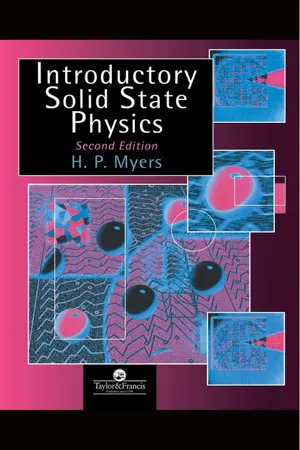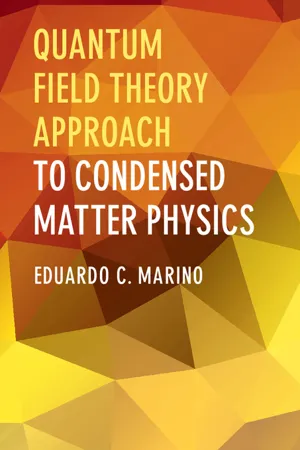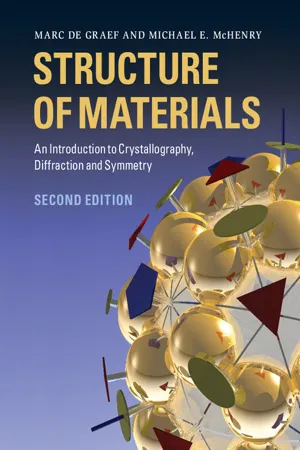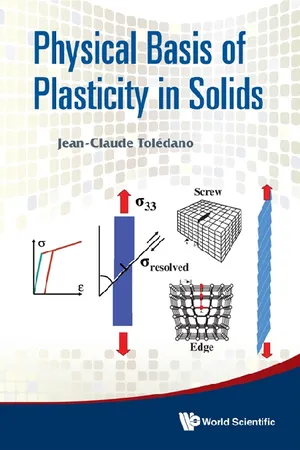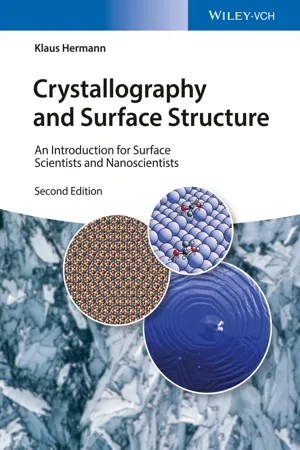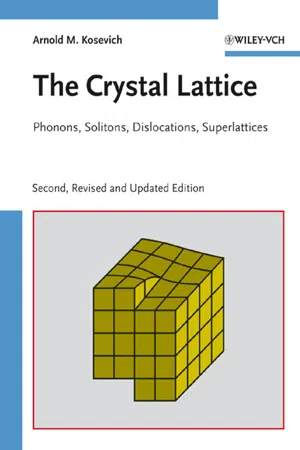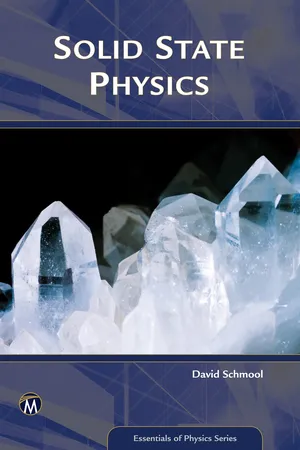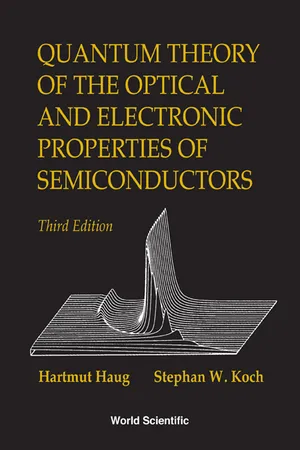Physics
3D Lattice
A 3D lattice refers to a regular, repeating arrangement of points or nodes in three-dimensional space. In physics, this concept is often used to model the structure of crystalline solids, where atoms or molecules are arranged in a repeating pattern. The lattice structure is important for understanding the properties and behavior of materials at the atomic level.
Written by Perlego with AI-assistance
Related key terms
1 of 5
11 Key excerpts on "3D Lattice"
- William D. Callister, Jr., David G. Rethwisch(Authors)
- 2020(Publication Date)
- Wiley(Publisher)
Sometimes the term lattice is used in the context of crystal structures; in this sense lattice means a three-dimensional array of points coinciding with atom posi- tions (or sphere centers). crystal structure lattice (a) (b) (c) Figure 3.1 For the face-centered cubic crystal structure, (a) a hard-sphere unit cell representation, (b) a reduced- sphere unit cell, and (c) an aggregate of many atoms. [Figure (c) adapted from W. G. Moffatt, G. W. Pearsall, and J. Wulff, The Structure and Properties of Materials, Vol. I, Structure, John Wiley & Sons, 1964. Reproduced with permission of Janet M. Moffatt.] The atomic order in crystalline solids indicates that small groups of atoms form a repeti- tive pattern. Thus, in describing crystal structures, it is often convenient to subdivide the structure into small repeat entities called unit cells. Unit cells for most crystal structures are parallelepipeds or prisms having three sets of parallel faces; one is drawn within the aggregate of spheres (Figure 3.1c), which in this case happens to be a cube. A unit cell is unit cell 3.3 UNIT CELLS 52 • Chapter 3 / The Structure of Crystalline Solids chosen to represent the symmetry of the crystal structure, wherein all the atom positions in the crystal may be generated by translations of the unit cell integral distances along each of its edges. Thus, the unit cell is the basic structural unit or building block of the crystal structure and defines the crystal structure by virtue of its geometry and the atom positions within. Convenience usually dictates that parallelepiped corners coincide with centers of the hard-sphere atoms. Furthermore, more than a single unit cell may be chosen for a particular crystal structure; however, we generally use the unit cell having the high- est level of geometrical symmetry. The atomic bonding in this group of materials is metallic and thus nondirectional in nature.- eBook - PDF
- H.P. Myers(Author)
- 1997(Publication Date)
- CRC Press(Publisher)
2 Crystallography 2.1 Lattices We are most familiar with condensed matter in the form of solid crystalline substances and, although interest in liquids and amorphous solids has grown considerably in the past few years, the physics of condensed matter is to a very great extent the physics of crystals. To begin, we therefore need to learn how to describe the regular geometrical arrangement of atoms in space that is the essence of crystallinity. Crystals are finite regular arrangements of atoms in space. In practice the atomic arrangement is never perfect, but in crystallography we neglect this aspect and describe crystals by reference to perfect infinite arrays of geometrical points called lattices. A lattice is an infinite array of points in space so arranged that every point has identical surroundings. All lattice points are geometrically equivalent. A lattice therefore exhibits perfect translational symmetry and, relative to an arbitrarily chosen origin, at a lattice point, any other lattice point has the position vector (2.1) The numbers n are necessarily integral and the vectors a, b and c are fundamental units of the translational symmetry; the latter are arbitrary, but a sensible choice is usually that which gives the shortest vectors or the highest symmetry to the unit cell. On the other hand, by definition, the volume associated with a single lattice point is unique, but since there is a choice regarding the vectors a, b and c, it may take a variety of shapes as illustrated for a two-dimensional example in Figs 2.1 and 2.2. The volume associated with a single lattice point is called the primitive cell, and this usually takes one of two forms. - Eduardo C. Marino(Author)
- 2017(Publication Date)
- Cambridge University Press(Publisher)
Part I Condensed Matter Physics 1 Independent Electrons and Static Crystals The expression “condensed matter” refers to materials that are either in a solid or in a liquid state. Soon after the atomic theory was established, the structure of matter in these condensed forms became the object of study under that new perspective. These early investigations already revealed that a large amount of the solids, interestingly, exhibit a peculiar structure, which is called a crystal. These rich forms of matter surprisingly assemble their constituent atoms or molecules in such a way that the most stable configuration has a periodic character, namely, there exists a basic unit that repeats itself along the whole sample. The specific geometric form of the periodic crystalline structure is determined by the spatial orientation of the atomic or molecular valence orbitals of the basic components of each crystal material. The existence of this periodic geometric array exerts a profound influence upon the physical properties of the material. These include the energy spectrum, charge and heat transport, specific heat, magnetic and optical properties. The study of crystal lattices, consequently, is of fundamental importance in the physics of condensed matter. 1.1 Crystal Lattices The mathematical concept that most closely describes an actual crystal lattice is that of a Bravais lattice, a set of mathematical points corresponding to the discrete positions in space given by {R| R = n 1 a 1 + n 2 a 2 + n 3 a 3 ; n i ∈ Z}, (1.1) where a i , i = 1, 2, 3 are the so-called primitive vectors in three-dimensional space. The corresponding structure in one(two)-dimensional space would be analogous to (1.1), but having only one(two) primitive vector(s). We can see that the points in the Bravais lattice form a pattern that repeats itself periodically. A characteristic feature of this type of mathematical structure is that it looks exactly the same from the perspective of any of its points R. 3- eBook - PDF
Structure of Materials
An Introduction to Crystallography, Diffraction and Symmetry
- Marc De Graef, Michael E. McHenry(Authors)
- 2012(Publication Date)
- Cambridge University Press(Publisher)
As a consequence of this invariance, all lattice points are identical . This is illustrated in Fig. 3.4 : we can choose any lattice point as the origin, and the surroundings of all lattice points are identical, as indicated by the thin lines around points 0, 1, and 2. The space lattice is a purely mathematical abstraction and does not contain any atoms or molecules at all . However, we can take a molecule and attach it to each lattice point to obtain a crystal structure. We thus find that a crystal structure consists of a 3-D space lattice that is decorated with atoms. The lattice is a 3-D assembly of mathematical points, which reflect the translational symmetry of the crystal. In general, any 3-D lattice can be fully described by stating the lengths of the three basis vectors and their mutual angles. According to the International Tables for Crystallography ( Hahn , 1989 ) the following notation should be used to describe the dimensions of a 3-D lattice: a = length of a ; b = length of b ; (3.4) c = length of c ; α = angle between b and c ; β = angle between a and c ; (3.5) γ = angle between a and b . It is easy to remember the angle designations: for any pair of vectors, say, a and c , take the missing letter (in this case b ) and turn it into a Greek letter (in this case β ). These six quantities fully specify the space lattice (see Fig. 3.3 ). The choice of the shortest lattice vector as either a , b , or c will depend on the symmetry of the lattice. We will often write the six numbers as { a , b , c , α , β , γ } ; they are known as the lattice parameters . For a 2-D net, the net parameters are usually written as { a , b , γ } . 56 What is a crystal structure? The volume defined by the three basis vectors (shown by the dotted lines in Fig. 3.3 ) is known as the unit cell of the space lattice. It is customary to define the vectors in such a way that the reference frame is right-handed. - eBook - PDF
- Jean-claude Toledano(Author)
- 2011(Publication Date)
- World Scientific(Publisher)
Chapter 2 The structure of crystalline solids Main ideas: Algorithm of construction of a crystal (lattice + basis). Geomet-rical implications of the three-dimensional periodicity (lattice planes and rows), restrictions on the values of rotation angles and on the unequivalent types of Bravais lattices. Different types of unit cells. Simple packings of atoms. 2.1 Introduction Considered at the atomic scale, solids are part, as well as liquids, of the condensed matter systems, in which the atoms are in “contact” with ea-chother. Their well defined external shape, in given conditions of stresses and of temperature, is related to the fact that the equilibrium position of each atom, referred to a frame attached to the solid, is “fixed”. 1 From the standpoint of the spatial configuration of their constituting atoms, several types of solids exist. One distinguishes crystalline solids from non-crystalline ones (amorphous, quasi-crystalline, etc...). For reasons stated in the introductory chapter, it is mainly the crystalline solids which will be described in this chapter. In these systems, observations by means of instruments giving access to the atomic-scale, show the occurence of specific geometrical regularities in the relative positions of the microscopic constituents. 2 Understanding these regular patterns is a necessary step 1 The correctness of the preceding statement requires mentioning that the concerned atomic positions are average positions of the atomic nuclei. Indeed, the atoms in a crys-tal are in constant motion, vibrating about a point which is their average equilibrium position, with amplitudes of the order of 5.10 − 2 ˚ A at room temperature.The measure-ments of these positions (by X-ray or microscopic techniques) are performed on time scales which are very large with respect to the periods of the vibrations. They therefore reveal, consistently with the above definition, the average atomic positions. - eBook - ePub
One-Dimensional Metals
Conjugated Polymers, Organic Crystals, Carbon Nanotubes and Graphene
- Siegmar Roth, David Carroll, David L. Carroll(Authors)
- 2015(Publication Date)
- Wiley-VCH(Publisher)
polycrystalline. They are composed of microcrystalline domains or grains, which stick together to form the bulk solid. The diameter of a grain can be from fractions of a micrometer up to several millimeters.The long-range order in a crystal leads to the crystal lattice. In a crystal lattice, the regular arrangement of the atoms (or molecules) is periodic; the same pattern is repeated over and over again (cf. sodium lattice in Figure 3.2 ; sodium chloride lattice in Figure 3.4 . Three repeating units in each direction are shown.) In order to classify the many different lattice types, their symmetry properties are used. (There are many textbooks of crystallography. However, Ashcroft and Mermin [1] has long been a standard for understanding crystal symmetries at the elementary level.) The lattices in Figures 3.2 and 3.4 are cubic. A cubic elementary cell, which is a commonly found repeating unit, can be constructed as indicated in bold in the upper right corner. For the sake of clarity, only the atoms at the surface of the crystal are shown while the atoms “inside” are omitted. (Examples of textbooks on crystal structure and chemistry are [4–6].)Crystal lattice of sodium metal.Figure 3.2This first example (Figure 3.2 ) is of a simple cubic system. That is, each site of the mental construct of the lattice (the mathematical arrangement of points in a regular square array) is occupied by an atom to form a real lattice of the solid. The subtlety (and formality) of forming the mental construct first, then filling in with atoms is an important one. After all, we need not imagine only one atom associated with a given site. Consider associating more than one with each site of the square lattice. The picture could get rather complex. The associated group of atoms placed on each lattice site is referred to as a “basis.”The use of a basis set is illustrated in Figure 3.3 - eBook - PDF
- Steven M. Girvin, Kun Yang(Authors)
- 2019(Publication Date)
- Cambridge University Press(Publisher)
5 Dynamics of Lattice Vibrations Now that we have warmed up in the previous chapter with a study of the simple 1D harmonic oscilla-tor, let us attempt a more realistic model of the lattice vibrations in a 3D crystal. We begin here with a classical analysis and later, in Chapter 6 , we will study the underlying quanta of sound waves known as phonons. These lattice vibrations carry energy and contribute signicantly to the heat capacity and the thermal conductivity of many solids. Particularly in insulators, where the electronic contributions are nearly negligible, lattice vibrations dominate the thermodynamic properties. It may seem complicated to have to deal with the enormous number of motional degrees of freedom (3 N in a crystal of N atoms), but we will see in this chapter that the translation symmetry of the crystalline lattice allows vast simplification of the description of the dynamics of the particles. To get started, we will first ignore the discrete atomic structure of the crystal and treat it as an elastic continuum with complete translation symmetry. After studying elasticity in the continuum, we will move on to a more realistic approximation that takes into account the detailed microscopic structure of the atomic lattice. This is will lead to significant differences in the collective mode properties at short wavelengths, where the modes are sensitive to the underlying discrete atomic structure of the solid. 5.1 Elasticity and Sound Modes in Continuous Media Elastic distortions of the crystal displace the atoms from their nominal equilibrium positions. The displacement vector u j was defined in Eq. ( 4.9 ). The elastic continuum approximation is appropriate if u j = u ( R j ) varies slowly with R j , in which case we can ignore the discrete nature of R j , and treat it as a continuous variable r . In this continuum limit u j = u ( R j ) is replaced by a displacement field u ( r ) describing the elastic deformations. - eBook - PDF
Crystallography and Surface Structure
An Introduction for Surface Scientists and Nanoscientists
- Klaus Hermann(Author)
- 2016(Publication Date)
- Wiley-VCH(Publisher)
7 2 Bulk Crystals: Three-Dimensional Lattices This section deals with the geometric properties of three-dimensional bulk crystals, which are described, in their perfect structure, by atom arrangements that are periodic in three dimensions. As an example, Figure 2.1 shows a section of a tetragonal YBa 2 Cu 3 O 7 crystal, where vectors R 1 , R 2 , R 3 (lattice vectors) indicate the mutually perpendicular directions of periodicity. Further, the basis of the crystal structure consists of 13 atoms (1 × yttrium, 2 × barium, 3 × copper, 7 × oxygen) inside a rectangular block (unit cell) that is repeated periodically inside the crystal. The building unit is shown to the left of the figure. In this section, all basic definitions used for a quantitative description of structural properties of perfect three-dimensionally periodic crystals will be provided. Here, the crystals are considered not only in terms of their translational symmetry, that is, periodicity, but also by their different point symmetry elements, such as inversion points, mirror planes, or rotation axes, which characterize the positions of all atoms inside a crystal. While the definitions and general properties are rather abstract and mathematical, they can be quite relevant for theoretical studies of real three-dimensional crystals. As an example, lattice representations of crystals are required as input to any electronic structure calculation for solid crystalline material. Further, the theoretical treatment of three-dimensional crystals serves as a foundation to study the surfaces of single crystals, as will be discussed in Chapters 4, 5, and 6. 2.1 Basic Definition The basic definition of a perfect three-dimensional bulk crystal becomes quite clear by considering a simple example. Figure 2.2a shows a section of the cubic CsCl crystal, which is periodic in three perpendicular directions. - eBook - PDF
The Crystal Lattice
Phonons, Solitons, Dislocations, Superlattices
- Arnold M. Kosevich(Author)
- 2006(Publication Date)
- Wiley-VCH(Publisher)
To do this efficiently, the fundamental properties of the simplest forms of solids, i. e., single crystals must be understood. Not so long ago, materials science implied the development, experimental investi- gation, and theoretical description, of primarily construction materials with given elas- tic, plastic and resistive properties. In the last few decades, however, new materials, primarily crystalline, have begun to be viewed differently: as finished, self-contained devices. This is particularly true in electronics and optics. To understand the properties of a crystal device it is not only necessary to know its structure but also the dynamics of physical processes occurring within it. For example, to describe the simplest displacement of the crystal atoms already requires a knowl- edge of the interatomic forces, which of course, entails a knowledge of the atomic positions. The dynamics of a crystal lattice is a part of the solid-state mechanics that studies intrinsic crystal motions taking into account structure. It involves classical and quan- tum mechanics of collective atomic motions in an ideal crystal, the dynamics of crystal lattice defects, a theory of the interaction of a real crystal with penetrating radiation, the description of physical mechanisms of elasticity and strength of crystal bodies. In this book new trends in dislocation theory and an introduction to the nonlinear dynamics of 1D systems, that is, soliton theory, are presented. In particular, the dis- location theory of melting of 2D crystals is briefly discussed. We also provide a new treatment of the application of crystal lattice theory to physical objects and phenomena whose investigation began only recently, that is, quantum crystals, electron crystals on a liquid-helium surface, lattices of cylindrical magnetic bubbles in thin-film ferromag- netics, and second sound in crystals. - No longer available |Learn more
Solid State Physics
From the Material Properties of Solids to Nanotechnologies
- David Schmool(Author)
- 2016(Publication Date)
- Mercury Learning and Information(Publisher)
It should be evident that the calculation for a 3D Lattice is significantly more complex than for the 1D case, though for the low frequency (non-dispersive) limit, it can be shown that g(ω) varies as ω 2 . The FIGURE 5.4: Phonon density of states as a function of frequency.The different peaks correspond to the transverse and longitudinal vibrational modes. Lattice Vibrations • 143 total number of vibrational states for a 1D lattice was found to be equal to N, the number of atoms. In a three-dimensional solid this is 3N. Of these, one-third (N) are longitudinal modes and two-thirds (2N) are transverse modes. In Figure 5.3, the transverse (T) and lon- gitudinal (L) modes are indicated for a Pd fcc lattice. In Figure 5.4, we show a phonon density of states as a function of frequency for a fcc structure. The sharp peaks are common in such curves and arise from abrupt changes in slope, which occur due to the group veloc- ity of the phonons vanishing at these points. Such critical points are known as van Hove singularities. These also occur in the electronic spectra of solids for similar reasons and can be of considerable use in understanding electronic band structures, which we will discuss in Chapter 7. 5.3 VIBRATIONAL MODES OF A DIATOMIC 1D LATTICE We will return to a 1D chain of atoms, which can be considered to be a one-dimensional lattice with a basis. Here we will consider a chain of alternating atoms of masses, m 1 and m 2 , where for argu- ment sake we can write m 1 > m 2 and separated by a distance a. We will follow a similar analysis to that given above for the mona- tomic case. - Hartmut Haug, Stephan W Koch;;;(Authors)
- 1994(Publication Date)
- WSPC(Publisher)
Chapter 3 PERIODIC LATTICE OF ATOMS After our discussion of the basic optical properties of a single atom in Chap. 2, we now analyze how the atomic energy spectrum is modified in a solid. As our model solid we take a perfect crystal, where the ions are arranged in a periodic lattice. In the spirit of a Hartree-Fock or mean field theory, we assume that the influence of this periodic arrangement of ions on a given crystal electron can be expressed in the form of an effective periodic lattice potential which contains the mean field of the nuclei and all the other electrons. For simplicity we consider only ideal crystals, which consist of a per-fect ionic lattice and some electrons which experience the lattice periodic potential. We are interested in the wavefunctions and allowed energy states of a single electron moving in the effective lattice potential ^(r). Many-electron effects will be discussed in later chapters of this book. 3-1. Reciprocal Lattice, Bloch Theorem For the valence electrons in a crystal the lattice potential V 0 (T) is an attractive potential due to the superposition of the Coulomb potentials of the nuclei and the inner electrons of the ions. However, for our considera-tions we never need the explicit form of K 0 (r). We only utilize some gen-eral features, such as the symmetry and periodicity properties of the potential which reflect the structure of the crystal lattice. The periodicity of the effective lattice potential is expressed by the translational symmetry K 0 (r) = K 0 (r + R J , (3.1) where R„ is a lattice vector, i.e., a vector which connects two identical sites in an infinite lattice, which are n lattice cells apart. It is convenient to expand the lattice vectors §3-1 RECIPROCAL LATTICE, BLOCH THEOREM 31 R„ = Y. '' a '' (3 ' 2) where n f are integers and a, are the basis vectors which span the unit cells. Note that the basis vectors are not unit vectors and they are generally not even orthogonal.
Index pages curate the most relevant extracts from our library of academic textbooks. They’ve been created using an in-house natural language model (NLM), each adding context and meaning to key research topics.

